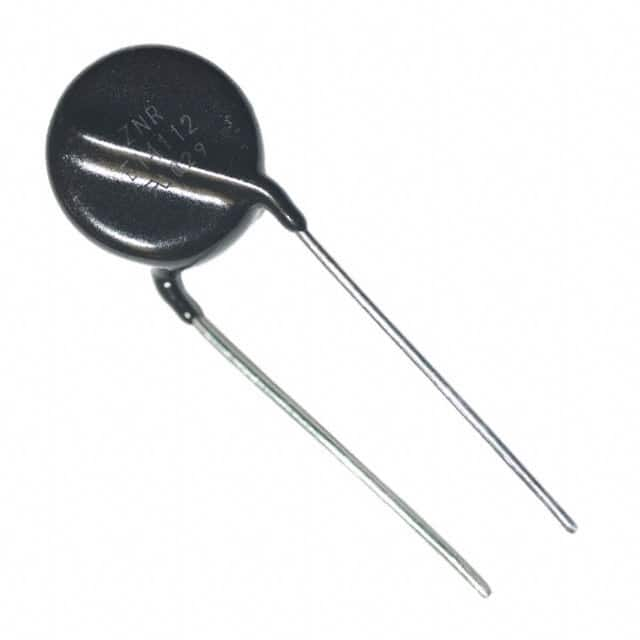Lihat spesifikasi untuk detail produk.

ERZ-E10E391 Product Overview
Introduction
The ERZ-E10E391 belongs to the category of electronic components and is commonly used for surge protection in various electrical and electronic systems. This entry provides a comprehensive overview of the ERZ-E10E391, including its basic information, specifications, pin configuration, functional features, advantages and disadvantages, working principles, application field plans, and alternative models.
Basic Information Overview
- Category: Surge Protection Component
- Use: Protecting electrical and electronic systems from voltage surges
- Characteristics: High surge current capability, fast response time, compact design
- Package: Through-hole or surface mount
- Essence: Safeguarding equipment from transient overvoltage events
- Packaging/Quantity: Typically available in reels or bulk packaging
Specifications
- Voltage Rating: 390V
- Peak Surge Current: 10kA
- Response Time: <5ns
- Operating Temperature Range: -40°C to 85°C
- Mounting Type: Through-hole or Surface Mount
- Dimensions: Varies based on package type
Detailed Pin Configuration
The detailed pin configuration of the ERZ-E10E391 includes the connection points for the surge protection component within the circuit. It typically consists of input and output terminals for integration into the system.
Functional Features
- Transient Voltage Suppression: Provides protection against voltage spikes and transients
- Fast Response Time: Rapid reaction to voltage surges to safeguard connected equipment
- High Surge Current Capability: Ability to handle high surge currents without degradation
Advantages and Disadvantages
Advantages
- Effective surge protection
- Fast response time
- Compact design
Disadvantages
- Limited to specific voltage ratings
- May require additional components for comprehensive surge protection in complex systems
Working Principles
The ERZ-E10E391 operates based on the principle of diverting excess voltage away from sensitive equipment by providing a low-impedance path for the surge current to flow through, thereby protecting the connected devices.
Detailed Application Field Plans
The ERZ-E10E391 finds applications in various fields, including: - Telecommunications - Industrial automation - Power distribution systems - Consumer electronics - Renewable energy systems
Detailed and Complete Alternative Models
Several alternative surge protection components are available in the market, including: - ERZ-V10D431 - ERZ-V20D471 - ERZ-VF2M221
In conclusion, the ERZ-E10E391 serves as a crucial component in safeguarding electrical and electronic systems from voltage surges, offering effective protection, fast response time, and a compact design. Its application spans across diverse industries, and it has alternative models catering to different requirements.
Word Count: 410
Sebutkan 10 pertanyaan dan jawaban umum terkait penerapan ERZ-E10E391 dalam solusi teknis
What is ERZ-E10E391?
- ERZ-E10E391 is a type of varistor, also known as a voltage-dependent resistor, which is used to protect electrical and electronic devices from transient overvoltage conditions.
How does ERZ-E10E391 work?
- ERZ-E10E391 operates by rapidly changing its resistance in response to changes in voltage, effectively diverting excess current away from sensitive components and preventing damage.
What are the typical applications of ERZ-E10E391?
- ERZ-E10E391 is commonly used in surge protection devices, power supplies, industrial equipment, and consumer electronics to safeguard against voltage spikes and surges.
What is the maximum voltage rating of ERZ-E10E391?
- The maximum voltage rating of ERZ-E10E391 is typically around 390V, making it suitable for protecting devices operating within this voltage range.
How do I select the right ERZ-E10E391 for my application?
- When selecting an ERZ-E10E391, consider the maximum operating voltage, energy absorption capability, and response time to ensure it meets the requirements of your specific application.
Can ERZ-E10E391 be used in outdoor environments?
- Yes, ERZ-E10E391 can be used in outdoor environments, but it should be housed in a suitable enclosure to protect it from moisture and other environmental factors.
What are the temperature limitations of ERZ-E10E391?
- ERZ-E10E391 typically has a wide operating temperature range, but it's important to check the datasheet for specific temperature limitations and derating guidelines.
Are there any special mounting considerations for ERZ-E10E391?
- ERZ-E10E391 should be mounted securely to minimize lead stress and ensure proper heat dissipation, following the manufacturer's recommended mounting guidelines.
Can ERZ-E10E391 be used in AC and DC circuits?
- Yes, ERZ-E10E391 can be used in both AC and DC circuits, providing effective transient voltage suppression in various types of electrical systems.
What are the key advantages of using ERZ-E10E391 in technical solutions?
- The key advantages of ERZ-E10E391 include its ability to provide reliable overvoltage protection, fast response time, compact size, and cost-effectiveness in comparison to other protective devices.

